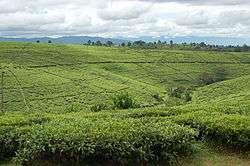Mbeya Region
| Mbeya Region Mkoa wa Mbeya (Swahili) | |
|---|---|
| Region | |
|
Tea fields in Tukuyu | |
 Location in Tanzania | |
| Country | Tanzania |
| Zone | Southern Highlands |
| Capital | Mbeya |
| Government | |
| • Regional Commissioner | Amos Gabriel Makalla |
| Area | |
| • Total | 62,420 km2 (24,100 sq mi) |
| • Land | 60,350 km2 (23,300 sq mi) |
| • Water | 2,070 km2 (800 sq mi) |
| Population (2012) | |
| • Total | 2,707,410 |
| • Density | 43/km2 (110/sq mi) |
| Time zone | EAT (UTC+3) |
| Postcode | 53xxx |
| Area code(s) | 025 |
| Website |
mbeya |
Mbeya Region is one of Tanzania's 30 administrative regions. It is located in the country's southwest. The regional capital is the city of Mbeya. According to the 2012 national census, the region had a population of 2,707,410, which was lower than the pre-census projection of 2,822,396.[1]:page 2 For 2002-2012, the region's 2.7 percent average annual population growth rate was tied for the tenth highest in the country.[1]:page 4 It was also tied for the eighteenth most densely populated region with 45 people per square kilometer.[1]:page 6 With a size of 62,420 square kilometres (24,100 sq mi),[2] the region is slightly smaller than the state of West Virginia in the United States (62,755 square kilometres (24,230 sq mi)).
The Mbeya Region is bordered to the northwest by Tabora Region, to the northeast by Singida Region, to the east by Iringa Region, to the south by Zambia and Malawi, and to the west by Rukwa Region.
The commissioner for the Mbeya Region is Abass Kandoro.[3]
Districts
The region is administratively divided into eight districts:
| Districts of Mbeya Region | |||||||
|---|---|---|---|---|---|---|---|
| Map | District | Population (2012) | |||||
 |
Chunya | 290,478 | |||||
| Ileje | 124,451 | ||||||
| Kyela | 221,490 | ||||||
| Mbarali | 300,517 | ||||||
| Mbeya | 690,598 | ||||||
| Mbozi | 446,339 | ||||||
| Momba | 294,380 | ||||||
| Rungwe | 339,157 | ||||||
| Total | 2,707,410 | ||||||
Geology
It was announced in February 2012 that the collapsed volcano approximately 200 km north of Mbeya, Mount Ngualla, contained one of the largest rare earth oxide deposits in the world.[4]
References
- 1 2 3 Population Distribution by Administrative Units, United Republic of Tanzania, 2013 Archived 2 May 2013 at the Wayback Machine.
- ↑ Statistical Abstract 2011, Tanzania National Bureau of Statistics Archived 5 November 2013 at the Wayback Machine.
- ↑ Kitabu cha Mawasiliano Serikalini, Tanzania Government Directory, 2012, page 173
- ↑ Peak Resources - Maiden Resource, Ngualla Rare Earth Project, ASX Announcement, 29 February 2012
Coordinates: 8°30′S 33°00′E / 8.500°S 33.000°E

